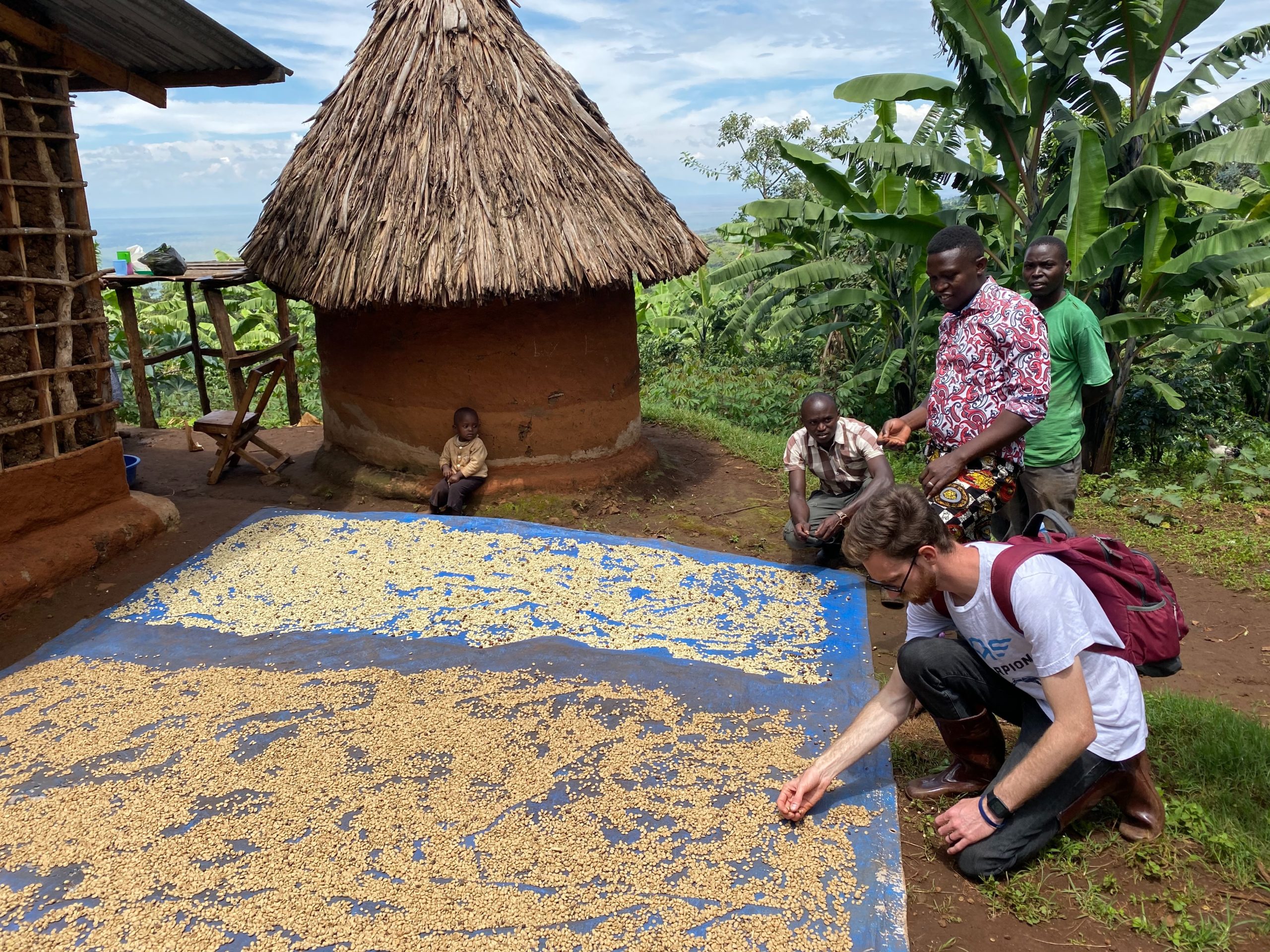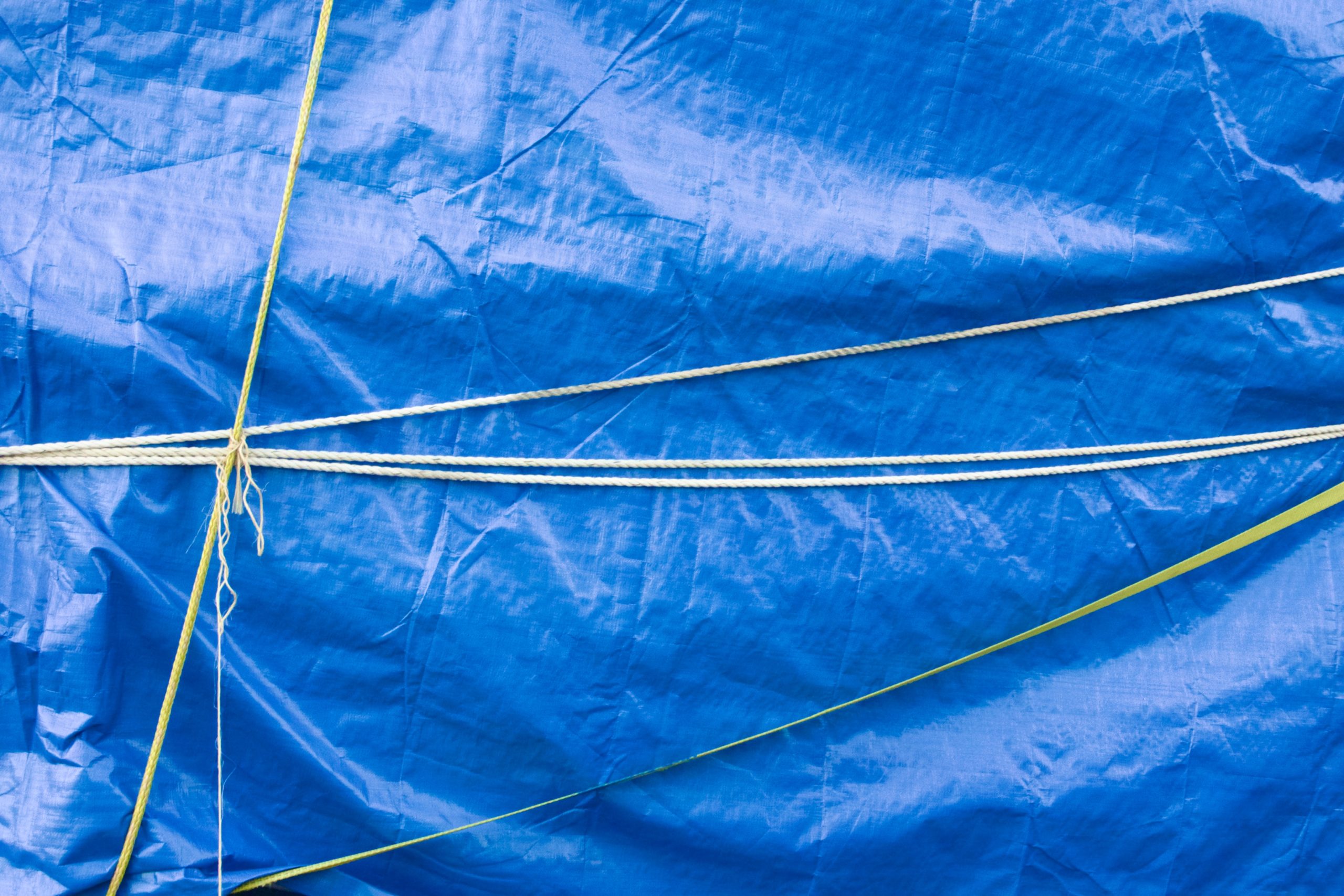Why is it important?
Plastic tarpaulins have been used in the field by humanitarian organisations since the 1980s. Every year, tens of millions of square metres of plastic sheeting are distributed to crisis-affected populations. They are used for a variety of purposes: emergency shelters, latrine covers, walls and fences (1).
Nowadays, tarpaulins are generally made of plastic, more specifically polyethylene (2). These materials have a significant negative impact on the environment, both during their production (fossil raw materials, energy use) and at the end of their life, when the tarpaulins distributed risk polluting the local environment due to the lack of local collection and recycling infrastructure. The UV resistance of tarpaulins is also a key factor: exposure to UV light can cause rapid degradation of the tarpaulin. For example, a plastic tarpaulin purchased locally in the Democratic Republic of the Congo breaks down after just 4 months’ use, whereas the standard tarpaulin currently in use still offers 90% tensile strength after 8 years.
What is the solution ?
Given the importance of tarpaulins to the humanitarian sector, the International Committee of the Red Cross (ICRC), the International Federation of the Red Cross (IFRC) and the United Nations Refugee Agency (UNHCR) designed in 2021 an eco–tarpaulin with a reduced environmental impact (3). After 3 years of labtests and studies, a life cycle analysis , an ultraviolet (UV) test, two field surveys and a scientific study of bio sourced, biodegradable and recycled materials, the new plastic sheeting is currently used in the field.
Switching to this new eco design tarpaulin for the 3 million of tarpaulins distributed every year would reduce the CO2e emissions by 69’000 tons every year in addition to the reduced toxic pollution and a reduced usage of resources. (16)
Confirmed success in reducing environmental impact (16)
Impact of 15% recycled polyethylene
Reduce global warming potential by 8% and fossil resource use by 8%.
Impact of 14% lighter in weight
Standard tarpaulins weighted 408kg in 1995, and this new version is 14% lighter with 4kg (for 4x6m model).
Impact of extended lifespan (doubled)
Stronger PE material and high UV resistance = potentially 50% reduction or more of the overall impact.
Impact of Long-term UV resistance
Extremely durable UV resistant PE: a long-term laboratory test equivalent to 10 years in real life demonstrated the extremely high UV resistance of the new tarpaulin compared to the tarpaulins one can find on every market.
Impact of recycling
Reduced global warming potential by 54% and fossil resource use up to 78%. Can be collected as a recyclable waste without degrading into microplastics. Made of pure PE, it is recyclable locally, to produced reusable PE granulates or upcycled into corrugated roof sheets.
Repairable
Repairable with adhesive tape or stitching.
Fire safety
Fire resistant without toxic chemical FR additives. This could allow the yearly suppression of at least 1000 tons of harmful chemicals.
Points of attention
-
Transport
The life cycle analysis carried out in the study assumes that the tarpaulins are shipped by sea. The impacts of transporting and distributing the tarpaulins will increase considerably if they are transported by air. Depending on the mode of transport chosen, the global warming potential can be 10 to 29 times higher (4).
-
Biodegradable and bio sourced plastics
Following the conclusions of the study, it was decided not to incorporate conventional biodegradable plastic (polyethylene) into the composition of the tarpaulins. The climatic conditions under which the tarpaulins are used are too varied and unpredictable to guarantee their durability in humanitarian contexts. Furthermore, the end of life is not controlled and in most cases will not meet the conditions of biodegradation. Bio sourced polyethylene will not be used either, as it has a higher environmental impact than fossil-based plastics in certain categories (use of resources, depletion of the ozone layer, human toxicity, terrestrial ecotoxicity, photochemical oxidation, acidification and eutrophication). There is also a potential conflict between food production and the production of bio-based plastics (5).

Good to know
-
Eco-design
The aim of eco-design is to minimise a product’s impact on the environment while meeting the needs of consumers and users. Eco-design takes environmental considerations into account throughout the life cycle of a good or service, right from the design stage. Eco-design therefore reduces greenhouse gas emissions linked to the product and its impact on the environment (10). It is common to see reductions in environmental impact of between 10% and 40% on several indicators (11). Life cycle analysis is often the basis of an eco-design project..
-
Life cycle analysis
A life cycle assessment (LCA) is a process for evaluating the effects of a product on the environment throughout its life. Carrying out an LCA of a product helps to optimise the use of raw materials and resources. LCA is sometimes referred to as a “cradle-to-grave” analysis. The key elements of LCA are:
- to identify and quantify the environmental elements involved, for example energy, raw materials consumed, CO2 emissions or waste generated;
- to assess the potential environmental impacts of these elements;
- to evaluate the options available to reduce these impacts (12).
Key actions
-
#1 Keep existing tarpaulin as long as possible
Even though they are less eco-friendly, keep the ancient model of tarpaulin already in stock or in use as long as possible, by storing in dry places away from sun or heat. Repair with tape or stitching and reuse.
-
#2 Shift all planned purchases to the Eco Design Tarpaulin
The IFRC/UNHRC/ICRC Eco design tarpaulins are available for Humanitarian Procurement center in the IFRC/ICRC Catalogue.
-
#3 Collect unwanted tarpaulins
After a crisis when the plastic sheetings are not necessary anymore, or if they are worn out, make sure they are collected, dried, eventually repaired and stored properly for reuse, or sent for recycling or final disposal.
-
#4 Recycle unusable tarpaulins
Recycle unusable tarpaulins by identifying reliable service providers, local if possible, or set up recycling projects. Due to its long lifespan, the Polyethylene sheet can be reused for making many different items like car tarpaulins, all kind of waterproof covers, big bags for waste collection, handbags, raincoats, ropes, etc. A project to encourage the local production of corrugated plastic roofing sheets by thermoforming end-of-life tarpaulins is currently being studied by the ICRC/IFRC/UNHCR (13)
-
#5 Raise awareness
Inform and train staff and beneficiaries to encourage the collection, repair and reuse of the tarpaulins, or at least its proper disposal.
To consider
-
Potential co-benefits
Can be upcycled to make corrugated roof sheets or transformed into PE granulates.
Cheaper to produce (6 to 25% cheaper than initial standard ones)
-
Prerequisite
To keep the benefit of the eco-improvement in production, the transport must be done by sea freight. Plan accordingly the orders and stock replenishment.
Likewise, the recycling must be organised in advance and planned for.
Tools and good practices
-
A Video presentation of the new eco design tarpaulin.
Click here -
Guide to the specification and use of plastic sheeting in humanitarian relief
This guide provides details and explanations on the use of tarpaulin in emergency situations.
Read here in English -
Recycle and disposal of emergency plastic sheets by Inter Agency Standing Committee
This guideline gives information on how to reuse, recycle and disposal plastic sheets after a humanitarian disaster, in this case with specific information for the context of Haiti.
Read here in English -
Practical guide to ecodesign, General confederation of small and medium-sized enterprises (CGPME), 2016 (FR)
This guide looks at the main concepts of eco-design and explains what is at stake. It also provides ideas for action and testimonials to help you understand how to take action and understand the eco-design approach.
Read here in French -
ISO Standard Life cycle analysis ISO14040, 2006 (EN)
ISO 14040: 2006 describes the principles and framework of life cycle assessment (LCA), with the following phases in particular : definition of the objective and scope of the LCA, analysis of the life cycle inventory (LCI), life cycle impact assessment (LCIA), interpretation of the life cycle, reporting and critical review of the LCA, the limits of the LCA, the relationship between the phases of the LCA and the conditions for use of value choices and optional elements.
Read here
Further reading
-
EPFL: Tarpaulins made from plant waste
At the École Polytechnique Fédérale de Lausanne, researchers have succeeded in transforming plant waste into biosourced and biodegradable polyester. The project was found not scalable and was discontinued.
Read here -
Eco-design project for tarpaulins: summary of LCA results, RISE, 2022 (EN)
The presentation provides a summary of the methodology, assumptions and main results of the LCA of the eco-designed tarpaulin.
Read here -
Factsheet on life cycle analysis, EcoAct (EN)
This document presents the methodology and use cases for life cycle analysis.
Read here -
Drowning in plastics - Charts on marine litter and plastic waste, United Nations Environment Programme, 2021 (EN)
The document provides an overview of the impacts of plastic pollution. Chapter 19 deals with the advantages and disadvantages of biodegradable plastics.
Read here -
Guide to the characteristics of tarpaulins and its use in humanitarian appeals, Humanitarian Library, 2008 (FR)
The document provides an operational explanation of the different uses of tarpaulins in the humanitarian sector.
Read here
Sources
(1) QSE Working group, The development of tarpaulins, 2015 (EN) Read here
(2) Plastic Le Mag, Plastics to the rescue of the homeless, 2014 (FR), Read here
(3) ICRC/IFRC/UNHCR, Eco-designed tarpaulin project, 2021 – 2023 (EN)
(4) RISE, Life cycle analysis of an ICRC woven PE tarpaulin, 2022 (EN)
(5) ICRC/IFRC/UNHCR, Eco-designed tarpaulin project 2021 – 2023, Project newsletter, 2022 (EN) Read here
(6) Organisation for Economic Co-operation and Development, Increase in plastic pollution, 2022. Read here
(7) ICRC/IFRC/UNHCR, Eco-designed tarpaulin project 2021 – 2023, Project newsletter, 2022 (EN) Read here
(8) ICRC/IFRC/UNHCR, Eco-designed tarpaulin project 2021 – 2023, Project newsletter, 2022 (EN) Read here
(9) Statista, Plastic can take 500 years to degrade in the oceans, 2018 (EN). Read here
(10) Eco-design of products, French Ministry of Ecological Transition, 2023 (FR). Read here
(11) Eco-design of products, French Ministry of Ecological Transition, 2023 (FR). Read here
(12) European Environment Agency, Life Cycle Analysis (EN). Read here
(13) ICRC/IFRC/UNHCR, Eco-designed tarpaulin project 2021 – 2023, Project newsletter, 2022 (EN) Read here
(14) ICRC/IFRC/UNHCR, Eco-designed tarpaulin project 2021 – 2023, Project Newsletter, 2022 (EN) Read here
(15) EPFL, Practical technologies for the global South – 2020 (EN) Read here
(16) Oger, Patrick. “ICRC Eco-Design Tarpaulin: End of Project Report | Logistics Cluster Website.” Logcluster.org, 27 Dec. 2023. Read here
Featured items
Non-food items

Procurement

